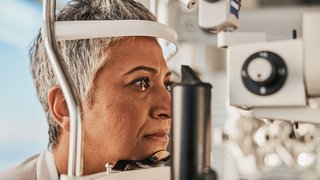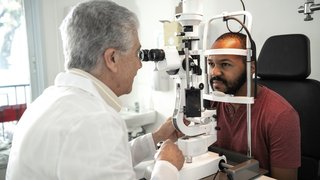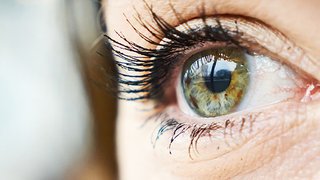Cataracts in children: Prevent vision loss with early detection and treatment
March 5, 2020

We typically think of cataracts occurring later in life, and with good reason: 90% of cataracts develop in seniors. But children can also develop cataracts.
A cataract is any cloudiness or opacity in the lens of the eye. A healthy lens is clear and allows light entering the eye to focus an image clearly on the retina. If a person has a cataract, the light rays scatter or are blocked as they pass through the cloudy lens, distorting and blurring the image.
Approximately three in 10,000 children have cataracts, a condition that is the leading cause of lifelong, but treatable, visual impairment. UT Southwestern ophthalmologists see pediatric cataract patients regularly at Children's Health and also participate in clinical studies to provide the most advanced care. Our ophthalmologists also see pediatric patients at the UT Southwestern Medical Center in Frisco.
Normal visual development is typically complete by the teen years or young adulthood. In these patients, if cataracts cause vision loss, vision can be completely restored by surgery to remove the cataract and implant an intraocular lens. With advanced intraocular lenses, it is also possible that the patient might not need glasses anymore.
In young children, the child’s retina has to have a clear imagine for the brain to receive a clear image. If a cataract blocks or blurs light entry through the lens, it interrupts and limits connections between the eye and the brain, leading to abnormal visual development and amblyopia (lazy eye). Prompt and sometimes immediate treatment is necessary to prevent permanent vision loss.
What causes cataracts in children?
Pediatric cataracts can be congenital (present at birth) or acquired (develop after birth). According to the American Academy of Ophthalmology, 50% of childhood cataracts are caused by genetic mutations.
Pediatric cataracts may present at birth or develop anytime during childhood. Most pediatric cataracts are isolated and not associated with other abnormalities.
Abnormal lens development during gestation is often the cause of pediatric cataracts. Cataracts can result from genetic problems such as Down syndrome, or infections such as rubella. Others occur spontaneously. Lens malformations in conjunction with medical problems are often the result of a genetic or metabolic problem such as Marfan's syndrome or diabetes.
How do you know if your child has cataracts?
In rare cases, a congenital cataract may be detected on an ultrasound before birth. More often, they are diagnosed within a few days after birth, during a well-baby exam in the following months, or during an annual vision screening.
Pediatric cataracts often can’t be seen by the naked eye, and some children might not display symptoms until the condition becomes severe. This is why regular vision screenings are so important.
Age and time are everything in diagnosing and treating pediatric cataracts. If your child exhibits any of the following symptoms, visit the pediatrician:
- Decreased vision
- Cloudy spot in the eye
- Light sensitivity
- White or dark pupil reflex in photographs
- Wandering or crossed eye
How are pediatric cataracts treated?
The treatment approach will depend on the size and location of the cataract. Small cataracts that don’t interfere with vision might not need immediate treatment.
Larger cataracts or those that affect a child’s vision will need to be surgically removed. This should be done as soon as possible, even in the first weeks of life, to improve vision and prevent future impairment.
Not all pediatric ophthalmologists perform cataract surgery. I’m one of the few physicians in North Texas who has surgically treated pediatric cataracts, with good results.
Surgery will remove the cloudy lens. In children 12 months or older, an artificial lens may be placed in the eye during the surgery, similar to cataract surgery in adults. However, intraocular lens placement is generally not recommend for children younger than one year due to the rapid growth of the eye. Because of this growth, contacts or glasses can help them see. Even with an artificial lens in the eye, glasses are still needed to help them see clearly.
Depending on the age of the child and the severity of the cataract, the eye-brain connection might need to be repaired or the eyes taught to focus properly. This could involve using eye patches or drops in the good-vision eye to stimulate vision in the poor-vision eye.
Regular visits will be necessary to check for potential complications such as glaucoma, or elevated pressure in the eye. Diligent follow up also will allow the doctor to check the refraction changes, update the prescription for glasses, and monitor amblyopia (lazy eye) treatment to ensure the best long-term vision outcome and reduce the risk of permanent vision impairment.
Cataracts can return after surgery especially in very young children. However, if the rejuvenated lens material does not block the visual pathway, it can be observed with close follow up. It is important to keep regular eye exams to allow for early detection of recurrent cataracts and prevent long-term risk conditions as such glaucoma.
Children whose cataracts are diagnosed and treated promptly have an excellent chance of growing up without significant vision impairment. We will work with you and your child to develop an individualized plan that addresses their specific needs to give them the best possible visual outcome.
To request an appointment, call 469-303-4100 (Children’s Health in Plano) or 469-604-9000 (UT Southwestern Ophthalmology in Frisco). You can also request an appointment online.











